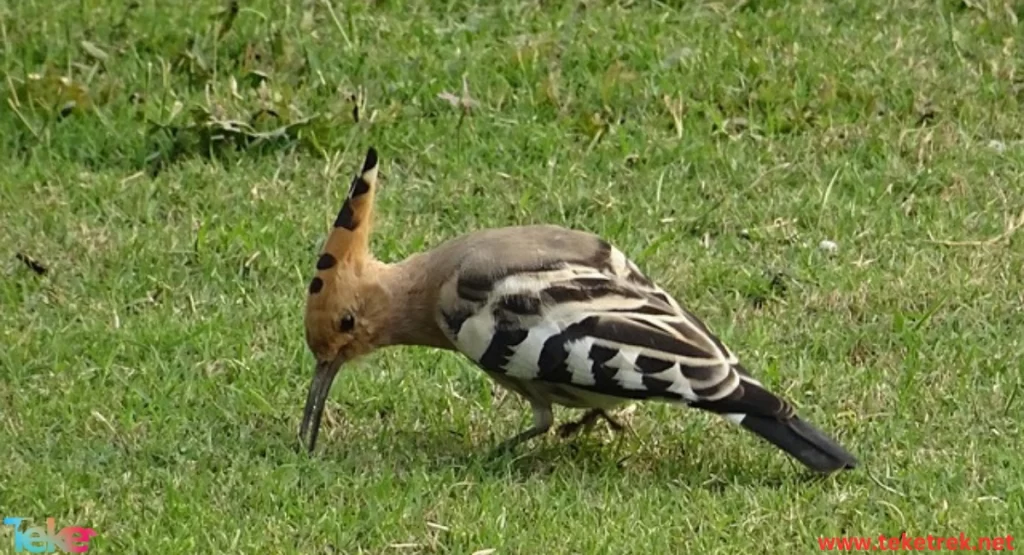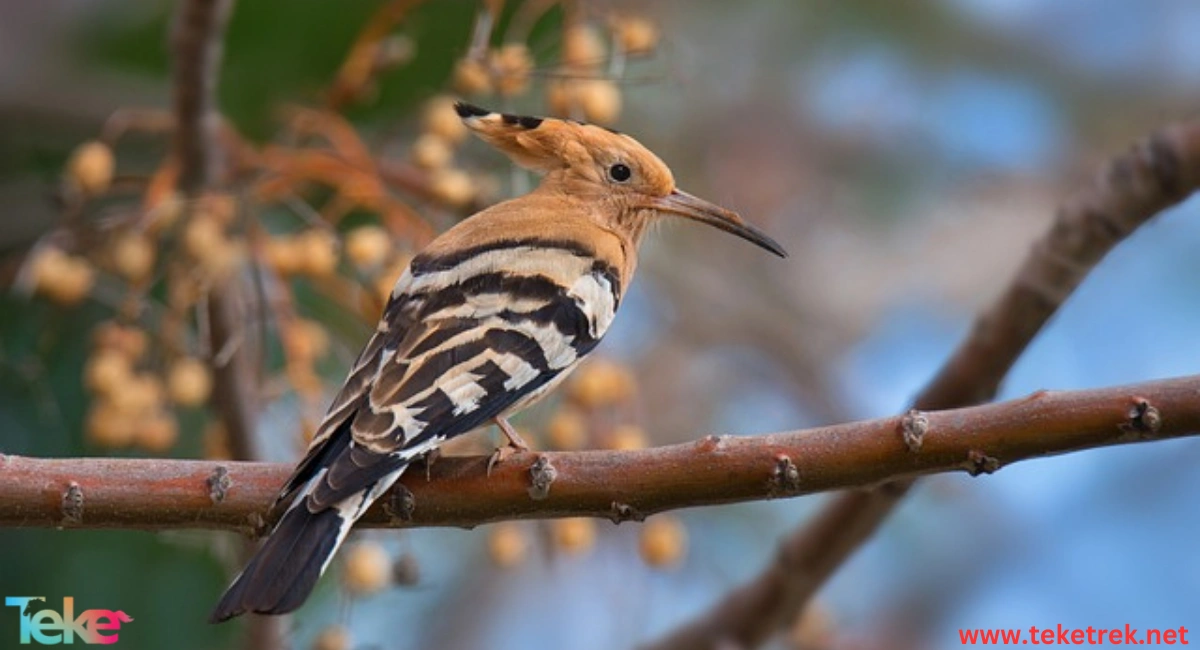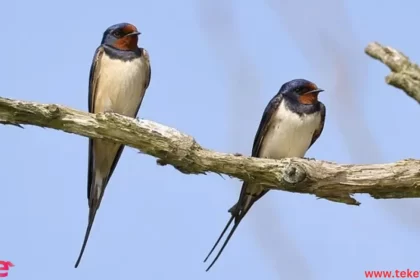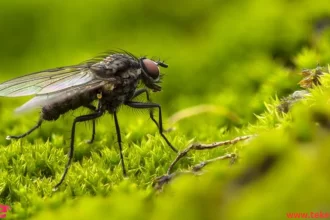The hoopoe is a beautiful, colorful bird that impresses many with its beauty and charm. It is considered a small bird with long wings and a round tail. It is distinguished by its bright feathers and distinctive colors, which make it the focus of everyone’s attention. There are many species of hoopoe around the world, and each species has its own unique characteristics and strange behavior.
The hoopoe lives in various regions around the world, from tropical to sub-continental regions, and feeds on a variety of insects, worms, and fruits. It is considered a skilled aerial bird, as it has a high ability to fly and move between trees smoothly.
In this article in TekeTrek website, we will explore more details about the world of the hoopoe, from its daily life to its behavior and the importance of its role in the environment. We will also learn secrets about the wonderful hoopoe and take a deep look at the way it adapts to its surrounding environment and its role in the balance of the ecosystem.

About the hoopoe
- The hoopoe, plural of hoopoe and hoopoe, has a distinctive crest on top of its head, colored light brown, and has a distinctive way of flying.
- The hoopoe feeds on insects and is considered a friendly friend of farmers, as it cleans the lands of pests, worms and larvae and is considered the king of birds.
It includes the following three types
- Eurasian hoopoe:
An Old World bird, the Eurasian hoopoe is located in large areas of Europe, South Asia, and other parts of Africa.
The Eurasian hoopoe loves to be in open spaces and is often found around human habitations, such as public parks, suburbs, vineyards and orchards.
This species is found in foraging areas with suitable nesting cavities.
The Eurasian hoopoe feeds on insects, spiders, snails and other small invertebrates as well as small vertebrates such as small lizards, small rodents, and snakes as well as seeds and berries.
- The Malagasy hoopoe:
The Madagascan hoopoe is larger than the Eurasian hoopoe in size and has a thicker beak.
The Malagasy hoopoe is widespread in northern, southern and western Madagascar, but is rare in the east.
It is found in open areas with scattered trees, cultivated areas, plains, savannahs, farms, beaches and lakes.
The Madagascan hoopoe see at an altitude of more than 1,500 m.
It feeds on insects and larvae.
It selects food items from the surface, but may search the ground to find worms and larvae, and also searches for food in cavities between stones.
- The African hoopoe:
The African hoopoe is widely distributed throughout southern Africa.
Non-social in nature, it is found singly or in pairs.
It is distinguished from the Eurasian hoopoe by its chestnut color and the lack of white lines on its body.
The Madagascan hoopoe prefers open, dense areas and thorny forests in dry areas.
The Malagasy hoopoe feeds on insects and small creatures such as lizards that it finds in the ground.
It searches for food among fallen leaves and plants and digs the ground to get insects.
It uses its beak as a means of catching its prey.
Reproduction in the hoopoe
- The hoopoe is usually a quiet creature whose voice is only heard during the mating season (spring, summer), when it invents a song. The hoopoe’s voice is monotonous to attract females and attract their attention.
- The female lays between 4-7 eggs, which are blue-green at first but soon turn brown.
- The incubation period lasts between 14-20 days, during which the female remains sitting on the eggs to warm them and the male brings her food.
- Young chicks emerge blind and without feathers, like other birds.
- The father and mother bring food to the young in the nest for 26-32 days until we become self-reliant birds.
What are the most important characteristics of the hoopoe?
The hoopoe bird has many specifications that can be identified as its prominent features, the most important of these specifications are:
1. Bright colored feathers:
The hoopoe is characterized by bright and beautiful colored feathers in a variety of colors including green, blue, orange, white and black, making it a beautiful and eye-catching bird.
2. Long wings:
The hoopoe has relatively long wings, which helps it fly smoothly and control its movement efficiently.
3. Round tail:
The hoopoe’s tail is round and short, which enables it to control its balance while flying and moving between trees.
4. Long beak:
The hoopoe has a long, thin beak that it uses to catch insects and worms.
5. Adaptability:
The hoopoe is a bird adept at adapting to various environments, whether in urban or wild areas.
6. Distinctive sound:
The hoopoe makes a beautiful and distinctive sound called “Hadid”, which is considered a distinctive sign of this bird.
7. Skilled hunting:
The hoopoe is distinguished by its excellent hunting skills, as it can hunt insects and worms quickly and accurately.
These characteristics make the hoopoe one of the most colorful and beautiful birds, and contribute to making it admired by many.


The Hoopoe in Culture and Mythology: Symbolism Across Civilizations
The hoopoe holds significant cultural and heritage value. It is a bird rich in symbolism across various civilizations, frequently mentioned in ancient myths and in the Holy Quran. Here’s how the hoopoe is symbolically represented in different cultures:
- In Morocco, hoopoe blood is illicitly used in the preparation of some traditional and illegal remedies.
- In Greek mythology, the hoopoe is considered the king of birds.
- In Ancient Egypt, the hoopoe was depicted on temple and tomb walls, as it is a calm, shy bird that does not harm humans.
- In Islamic tradition, the Quran interprets the hoopoe as a key informer and messenger for Prophet Solomon (Sulaiman, peace be upon him), helping him locate underground water sources in the desert.
- In Turkish folklore, the hoopoe is considered a sacred bird known as Murg-i Suleiman (Solomon’s Bird), holding a noble place in Turkish history.
- In Persian literature, the hoopoe appears in numerous poems, most famously in “The Conference of the Birds” by the Persian poet Farid al-Din Attar, where it is portrayed as the leader and wisest among birds.
- In many Western cultures, the hoopoe symbolizes grace, loyalty, and wisdom. It is associated with good luck, progress, joy, and prosperity. In some traditions, it is also seen as a symbol of resilience and perseverance, admired for its ability to adapt and survive in various environments.
The Hoopoe in the Quran: The Story of Solomon and the Hoopoe
The religious significance of the hoopoe is most prominent in the story of Prophet Solomon. It represents wisdom and loyalty, as reflected in the following key points:
- The hoopoe is mentioned in the Quran in Surah An-Naml, verse 20:
“And he inspected the birds and said, ‘Why do I not see the hoopoe – or is he among the absent?’” - The hoopoe served as a messenger for Solomon, delivering his letter to the Queen of Sheba (Bilqis).
- It was elevated above other birds for its role in conveying the message of monotheism to the people of Sheba, who were previously sun-worshippers. Through the hoopoe’s report and intervention, they were guided to worship Allah.
- The Kingdom of Sheba, ruled by Prophet Solomon, was a unique society that included humans, jinn, and birds. It was highly organized, with strict schedules. When the hoopoe was late in returning, Solomon threatened punishment, as mentioned in the same Quranic verse.
The Hoopoe and Agriculture: The Farmer’s Hidden Ally
The hoopoe plays a crucial yet often overlooked role in farming. It assists farmers naturally during agricultural seasons, reducing the need for chemical pesticides through the following tasks:
- Known as the farmer’s friend (like the cattle egret), the hoopoe helps clean the land of decaying crops.
- It feeds on larvae, insects, worms, and pest eggs, acting as a natural pest control agent.
- It consumes flying and dead insects, helping keep the farmland clean and reducing the need for toxic insecticides, thanks to its long beak that is perfect for soil foraging.
The Hoopoe Under Threat: Is It an Endangered Species?
Like many bird species, the hoopoe is under environmental threat and may face extinction in the near future due to several negative factors:
- Superstitions and myths have led to excessive hunting in some cultures, where hoopoes are caught for use in witchcraft and sorcery.
- Some hunters see capturing a hoopoe as a challenge or a form of exotic sport.
- The bird is often poisoned unintentionally due to pesticides and chemical fertilizers used by farmers. As the hoopoe digs for food, it ingests toxins and dies.
- Many hoopoes die from collisions with wind turbine blades, especially in agricultural or desert areas.
Fascinating and Surprising Facts About the Hoopoe
The hoopoe holds a unique status among birds and cultures due to a number of intriguing traits:
- It rarely drinks water regularly since its diet is rich in fatty insects like worms and larvae, allowing it to maintain hydration in an unusual manner.
- The hoopoe can detect underground water by tapping its beak against the soil to analyze the composition and moisture levels.
- It stuns its prey by striking it against the ground to disable wings and legs before tossing it in the air and catching it with its beak.
- It is a fast flier, known for its intelligence, evasion tactics, and self-defense mechanisms.
- Instead of bathing in water, the hoopoe baths in sand and uses low-altitude flight as camouflage to avoid predators.
The Migratory Hoopoe: Journeys Across Continents
The hoopoe is a migratory bird, constantly moving between continents throughout the year. Here are its main migration patterns:
- The Eurasian hoopoe only settles during breeding season, migrating up to 8,000 kilometers annually in search of milder climates. It moves between southern Africa, the Arabian Peninsula, southern India, and Europe.
- The European hoopoe migrates south during winter to escape the cold, settling in warmer regions of the Southern Hemisphere.
How to Identify the Hoopoe?
Distinguishing the hoopoe from other birds is easy once you know its unique physical traits:
- It has colorful plumage with shades of black, white, green, blue, orange, and brown. Some species even display cinnamon or chestnut tones.
- Its long, broad wings are marked with striped patterns that enhance its maneuverability in flight.
- It stands 25–30 cm tall and weighs around 60 grams. It has a distinct feathered crest on its head, often displayed upright in a chestnut hue with darker tips.
- The hoopoe’s call is melodic and resembles soft classical music tones.
- Its long, slender beak is ideal for digging up worms and insects from beneath the soil.
Daily Behaviors of the Hoopoe: How It Spends Its Day
The hoopoe is a bird known for its unique appearance and distinctive behaviors. It inhabits a variety of environments, including agricultural areas, grasslands, and open forests.
The hoopoe is characterized by its colorful plumage, black and white wing stripes, and its iconic crest, which it raises and lowers depending on its mood.
It mainly feeds on insects, worms, and larvae, which it searches for on the ground using its long, pointed beak to pick them up.
Among its most notable behaviors are its distinctive undulating flight, the raising of its crest when excited, and dust-bathing as a form of self-defense.
When feeling threatened, the hoopoe sprays a foul-smelling liquid from a gland near its tail to protect itself from predators.
The Hoopoe’s Natural Enemies: What Threatens It
Birds of prey such as falcons and hawks are the hoopoe’s natural enemies, hunting it both in the air and on the ground, along with foxes and wild cats. These animals roam the land searching for easy prey, and the hoopoe is no exception. They hunt the hoopoe for food.
The hoopoe also faces danger from certain snakes that may sneak into its nests to eat its chicks.
In addition, other factors contribute to the decline of hoopoe populations, including habitat destruction, pesticide use, and hunting. Pollution and climate change also negatively impact the hoopoe.
The Impact of Climate Change on the Hoopoe’s Habitat
Climate change negatively affects the hoopoe’s habitat, posing a threat to its survival. The impacts include the degradation of vegetation cover, depletion of food sources, and increased drought — all factors that harm the hoopoe’s ability to survive and reproduce.
Here are the detailed issues:
- Vegetation Degradation:
Rising temperatures alter vegetation cover, which may affect the types of insects the hoopoe feeds on, thereby impacting its main food sources. - Water Scarcity:
Rising temperatures increase drought levels, reducing water availability, which negatively affects the hoopoe, especially in areas reliant on limited water sources. - Changes in Breeding Seasons:
Climate change can disrupt breeding cycles, affecting the timing of egg hatching and chick development, which decreases the chances of successful reproduction. - Increased Competition:
Climate change can cause other species to migrate into new areas they previously couldn’t inhabit, increasing competition for food and nesting sites, adding extra pressure on the hoopoe. - Forced Migration:
Climate change may force the hoopoe to migrate in search of suitable living conditions, which could lead to challenges in adapting to new environments.
The Hoopoe’s Body Language: How It Expresses Emotions
His body language is complex to express his feelings and different states such as threat, flirting, and caution. These signals can be observed through its body posture, movements of its crest (the feathered crown on its head), and the tone of its calls.
Expressing Threat:
- Standing Tall: The hoopoe tends to stand upright with its neck extended and feathers puffed out, making itself appear larger and stronger.
- Crest Movement: The hoopoe raises its crest and flicks it quickly back and forth to intimidate its opponent.
- Screeching Sounds: It emits sharp, loud sounds to show threat and aggression.
Expressing Courtship:
- Crest Movements: The hoopoe lowers its crest and moves it gently, signaling its desire to approach a female or request assistance.
- Body Movements: The hoopoe moves closer to the female and sways its body lightly, showing signs of interest.
- Tone of Voice: During courtship, the hoopoe uses a softer and calmer tone.
Expressing Caution:
- Standing Still: When sensing danger, the hoopoe stands still, carefully scanning its surroundings.
- Cautious Movement: The hoopoe moves slowly and carefully, trying to hide or escape.
- Soft Sounds: The hoopoe makes soft sounds to signal alertness or to ask for help.
The Hoopoe in Arts: Its Appearance in Painting, Poetry, and Music
The hoopoe appears in art as a symbol in painting, poetry, and music, often associated with many meanings and interpretations depending on culture and tradition. The hoopoe is also regarded as an aesthetic and literary symbol in many global and historical cultures, seen as a representation of wisdom, beauty, goodness, and a connection to royalty and sacred matters.
In Painting:
- The hoopoe is depicted in many paintings and artworks, especially in Islamic art.
- It is often illustrated as a bird with vivid colors and distinctive feathers, making it an attractive subject for artists.
- Sometimes, the hoopoe symbolizes wisdom, intelligence, and the ability to communicate between different realms in artwork.
In Poetry:
- It is mentioned in many poems, especially in Arabic literature.
- In poetry, it is known for its ability to speak and communicate with Prophet Solomon, making it a symbol of messages and divine revelation.
- It may also represent wisdom, intelligence, and the ability to uncover secrets.
In Music:
- The hoopoe can be the subject of songs or musical compositions, often inspired by its distinctive sounds.
- In some cultures, it is linked with rural or traditional music.
- The hoopoe’s sound might be used in music to add an air of mystery or nature.
How the Hoopoe Chooses Its Nesting Site
The hoopoe usually chooses elevated spots that provide safety for its nest, such as large tree holes, old walls, between rocks, or even man-made places like nesting boxes. It prefers locations with cavities or crevices that allow it to build a comfortable and secure nest.
Here are the main details of how the hoopoe chooses its nesting site:
- Elevated Locations: The hoopoe searches for relatively high places to protect itself from predators.
- Cavities: It prefers spots with natural or man-made cavities, such as tree holes, rock crevices, wall cracks, or even nesting boxes.
- Safe Areas: The hoopoe ensures the nesting site is safe for laying eggs and raising chicks, away from intruders and dangers.
- Close to Food Sources: It prefers nests near its primary food sources — insects and worms.
- Bare Ground or Light Vegetation: The hoopoe needs open ground to search for the insects and worms it feeds on.
Examples of Nesting Sites:
The nest can be in a tree hollow, a hole in a wall, or even a narrow entrance.
Frequently asked questions about the hoopoe
There are many questions asked by those interested in this beautiful bird, in terms of speed, reproduction, nutrition and other important information.
- What does the presence of a hoopoe in the house indicate?
The presence of the hoopoe in the home is considered a symbol of luck and happiness in some cultures and traditions. In some cultures, it is believed that seeing the hoopoe may be a sign of the arrival of good luck and new opportunities. Its presence in the garden or home is also considered a sign of peace and prosperity.
- Is the hoopoe fast?
The hoopoe is considered one of the fast and skilled birds in flight, as it is distinguished by its ability to fly at high speed and with sudden and precise movements. It can move very quickly and change directions smoothly in flight, making it an effective bird for hunting insects and feeding on the fly.
- What is the average lifespan of a hoopoe?
The average lifespan of the hoopoe ranges from 8 to 10 years in the wild, and it is important to note that there may be differences in the lifespan of the hoopoe depending on environmental conditions and external factors that affect the lives of these birds.
- Does the hoopoe drink water?
The hoopoe has a strange ability to seek water and discover its presence under the ground, as it sees water from a distance and feels it in the ground, so if it flies to a place, it knows that there is water in it.
- When does the hoopoe die?
The hoopoe dies four days after the death of his wife.
- What does the hoopoe symbolize?
The hoopoe is the wondrous bird of secrets, a symbol of penetrating insight, the king of birds and the messenger of the prophets.
- Where is the best place to see hoopoe؟
The best place: south coast promontories or the offshore islands.
- What is hoopoe called in English?
Called orange-pink bird.
In short
In short, it can be said that the hoopoe is considered among the most beautiful birds in our world, thanks to its colorful plumage and elegant way of flying. It is an amazing bird with many unique qualities that make it admired by many.
Thus, we have reached the conclusion of our article about the hoopoe, and we have learned the most important information about this distinctive bird, including its way of life, reproduction, types, and food, so that we have provided benefit.






